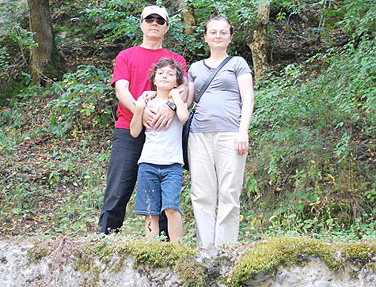News
Summer travel plugs into faculty research

UB physicists Avto Kharchilava and Ia Iashvili and their son, Giorgi, spent time this summer in Georgia, the Eastern European country where the couple’s son was born and where they still have family and friends.
-
 Print
Print -
 Comments
Comments
-
Giorgi Kharchilava stands in front of a mockup of the Large Hadron Collider tunnel showing the string of magnets. The photo picture was taken at the Microcosm exhibition at CERN. Click on the image to see a larger version.
Multimedia

During a fast melting of the Greenland Ice Sheet this July, two rivers flooded the area near Kangerlussuaq, washing away roads and bridges. One video shows efforts to save a bridge over the Watson River. The other provides an aerial view of the bridge and the raging river.
For many UB faculty researchers like Avto Kharchilava and Ia Iashvili, physicists and natives of the Eastern European country of Georgia, international travel isn’t a one-time sabbatical adventure or extension of their U.S. research; it’s an integral part of their lives year-round.
This summer was no exception. Kharchilava and Iashvili, who are married, and their son, Giorgi, had a packed itinerary, bouncing from the Netherlands in June to Melbourne, Australia, and Georgia in July, and then to Geneva, Switzerland, before heading back to Buffalo for the start of the school year.
“We were born in Georgia and try to visit our parents, relatives and friends there almost every summer,” Kharchilava explains of their July vacation, which included relaxing in the mountains and served as a much-needed break between their professional gigs.
In Melbourne, the couple participated in the 36th International Conference in High Energy Physics (ICHEP 2012), a series of conferences held every other year in various countries that Kharchilava describes as “the most important events in our field of research where the current state of particle physics, particle astrophysics and cosmology are discussed.”
The highlight this year’s ICHEP trip was the announcement of a new subatomic particle that resembles the elusive Higgs boson, a particle that, if it existed, would explain one of nature’s biggest secrets—why objects have mass.
When the particle’s discovery was announced July 4 at the European Organization for Nuclear Research (CERN) facility in Geneva, Switzerland, it was broadcast live to research labs and universities around the world. CERN’s Large Hadron Collider (LHC) is the world’s largest particle accelerator, designed to replicate the Big Bang and reveal subatomic particles like the Higgs boson.
Kharchilava and Iashvili have been working for years with research teams at CERN to plan and build the LHC’s Compact Muon Solenoid detector (CMS), a massive device that uses magnetic fields to conduct a wide range of physics experiments.
Kharchilava, who called the announcement of the particle’s discovery “breathtaking,” watched it unfold from the Melbourne Convention Center, where he gave a talk about Higgs particles as part of the ICHEP conference.
On July 12, Kharchilava and Iashvili left for Georgia to work with physics colleagues and take their long-awaited vacation. From there they traveled to Geneva, where the CMS team’s observations of the Higgs particle culminated in the July 31 publication of what Kharchilava proudly calls “one of the most important papers for many decades.”
During their stay, Kharchilava and Iashlivi skipped the usual leisure activities; the particle discovery was just too exciting and hectic. Like many scientists who work on large international teams, Kharchilava says, they only dropped in for a few days, ready to work. “There is virtually no time needed for adaptation—we come and are immediately at task,” he says.
Luckily, he and Iashvili are familiar with the CERN facility and its surrounding neighborhoods, where they lived in the 1990s before moving to the U.S. in 2000.
“Geneva, and especially CERN, is probably the best place to work in particle physics these days,” Kharchilava adds. The couple calls the city an “exceptional place in every sense,” on par with other places where they’ve spent extended time, including Berlin, Hamburg, Strassbourg and Chicago.


Reader Comments